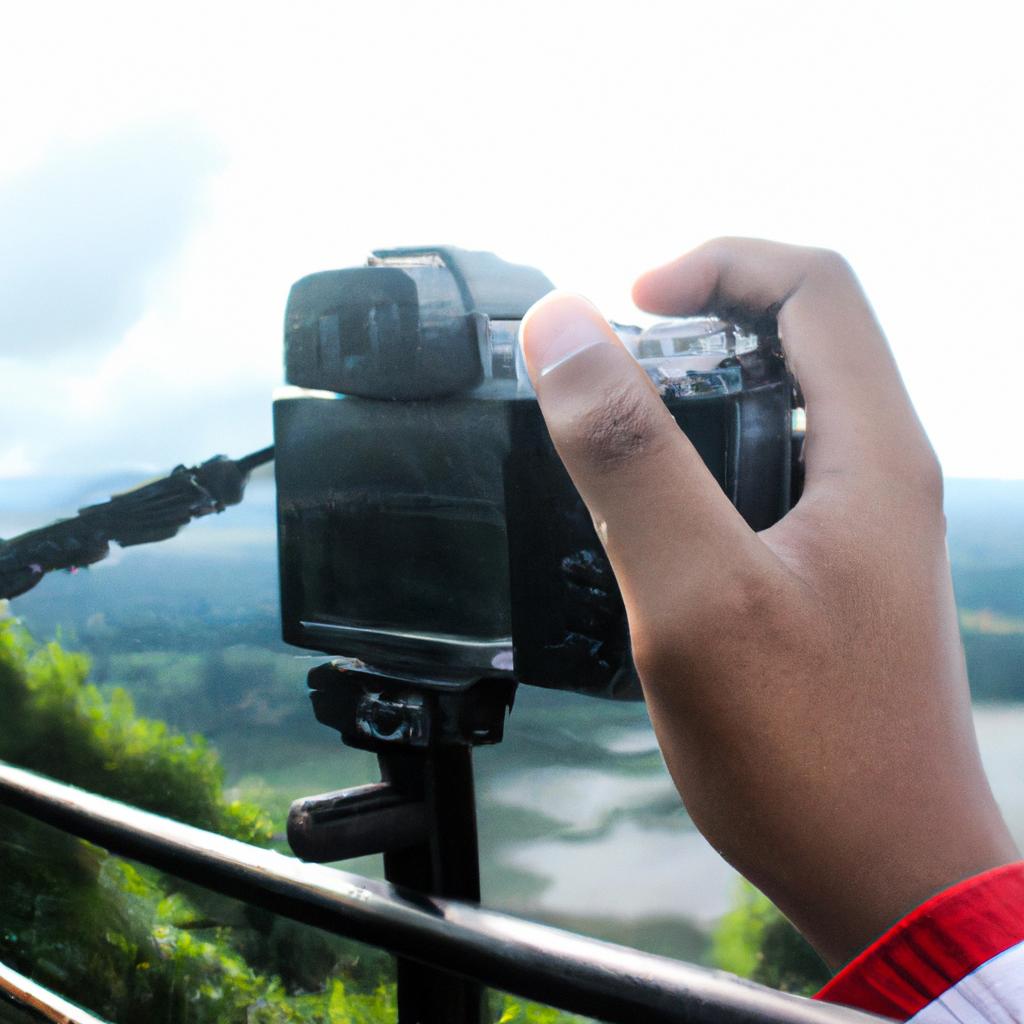Nature photography captures the inherent beauty of the natural world through the lens of art and photography. It serves as a medium to showcase the magnificent landscapes, intricate details, and diverse wildlife that exist all around us. This article explores the significance of nature photography in contemporary arts and its ability to evoke emotions, raise environmental awareness, and preserve our connection with nature.
Consider for instance a photograph capturing a majestic waterfall cascading down rugged cliffs, surrounded by lush greenery. The careful composition, lighting techniques, and post-processing methods employed by the photographer transform this scene into an exquisite work of art. Nature photography goes beyond mere documentation; it allows viewers to immerse themselves in a moment frozen in time and experience the awe-inspiring wonders of our planet. Through skillful manipulation of light and perspective, photographers create images that transport audiences to distant landscapes or bring them closer to delicate flowers blooming amidst urban settings.
The Role of Nature in Art
Nature has long been a significant source of inspiration for artists across various artistic disciplines. From literature to painting, nature’s beauty and grandeur have captivated the hearts and minds of creative individuals throughout history. This section will explore the essential role that nature plays in art, particularly focusing on its influence in photography.
To illustrate this point, let us consider the case study of renowned photographer Ansel Adams. Adams was deeply moved by the natural world and dedicated his life to capturing its awe-inspiring landscapes through his camera lens. His iconic black-and-white photographs not only showcased breathtaking scenes but also conveyed a sense of reverence and respect for nature’s power and majesty. Through his work, Adams demonstrated how nature can serve as both subject matter and muse for artists seeking to convey emotions and provoke thought.
When examining the relationship between nature and art, several key themes emerge:
-
Transcendence: The vastness and magnificence of nature often evoke feelings of transcendence within viewers. Whether it be standing at the edge of a towering mountain or gazing upon an endless horizon, these encounters with nature can transport individuals beyond their everyday lives into a realm where time seems suspended.
-
Serenity: Nature possesses an inherent tranquility that provides solace from the chaos of modern society. By immersing oneself in serene natural environments or viewing depictions thereof, one can experience a profound sense of calm and inner peace.
-
Introspection: As humans, we are intrinsically connected to our natural surroundings. Engaging with nature allows us to reflect on our place within the larger context of the universe, prompting contemplation about existence, purpose, and our responsibility towards preserving our environment.
-
Wonder: The intricate details found in even the tiniest elements of nature – from delicate petals to intricately patterned leaves – inspire wonderment in those who observe them closely. These marvels remind us of the complexity and beauty that exists within our world, encouraging a deeper appreciation for the natural wonders around us.
In summary, nature serves as a rich source of inspiration and subject matter for artists in various mediums. It provides an avenue for exploring themes such as transcendence, serenity, introspection, and wonder. In the following section, we will delve into how photographers specifically harness these qualities to capture the aesthetics of nature through their lens – aiming to bring its splendor to wider audiences while also provoking contemplation about humanity’s relationship with the natural world.
Exploring the Aesthetics of Nature Photography
Building upon the understanding of nature’s role in art, let us now delve into the unique aesthetics that are inherent to nature photography. By harnessing the power of light, composition, and subject matter, photographers can capture compelling images that transport viewers into the heart of the natural world.
Consider a hypothetical scenario where a photographer sets out to capture the essence of a serene forest during golden hour – that magical time just before sunset when warm hues blanket everything in sight. The interplay between sunlight filtering through leaves creates captivating patterns on the forest floor, while shadows add depth and intrigue. This scene exemplifies how nature photography allows artists to freeze moments in time and highlight elements not easily seen by an untrained eye.
Nature photography evokes various emotions within its audience as it immerses them into landscapes filled with both grandeur and subtlety. Here is an example bullet point list showcasing some emotional responses often elicited by this genre:
- A sense of awe at the vastness and beauty found in natural environments.
- Feelings of tranquility and peace experienced through visually capturing serene scenes.
- Fascination with intricate details present in close-up shots, revealing hidden wonders.
- Nostalgia for places once visited or yearning for those yet to be explored.
Furthermore, a table can be employed to showcase different aspects that contribute to the aesthetic appeal of nature photography:
| Aspect | Description | Example |
|---|---|---|
| Composition | Arrangement of visual elements within an image | Rule-of-thirds placement highlighting main subjects |
| Lighting | Manipulation and utilization of light | Soft morning glow casting ethereal atmosphere |
| Color Palette | Selection and juxtaposition of colors | Vibrant autumn foliage against a clear blue sky |
| Subject Matter | Choice and portrayal of focal points | Majestic mountains or delicate flowers in foreground |
By skillfully employing these aspects, photographers are able to craft images that evoke emotions and engage viewers on a deeper level. Ultimately, nature photography serves as a powerful medium for conveying the splendor of the natural world and fostering appreciation for its beauty.
Transitioning smoothly into the subsequent section about “Techniques for Capturing the Essence of Nature,” we can explore how photographers employ specific methods to encapsulate the essence of their subjects without simply listing steps or using transitional phrases like “next” or “then”.
Techniques for Capturing the Essence of Nature
Exploring the Aesthetics of Nature Photography: Techniques for Capturing the Essence of Nature
Continuing our exploration into the aesthetics of nature photography, let us delve deeper into some key techniques that can help photographers capture the essence and beauty of the natural world. To illustrate these techniques, let’s consider a hypothetical example where a photographer aims to capture the breathtaking sunset over a serene lake.
To effectively convey the emotions evoked by such a scene, photographers often employ various compositional techniques. These include:
- Framing: By using elements such as trees or rocks in the foreground, photographers can frame their subject and create a sense of depth within the image.
- Rule of Thirds: Dividing the composition into nine equal parts with two horizontal and two vertical lines allows for placing important elements at intersecting points, resulting in visually appealing images.
- Leading Lines: Utilizing natural lines, like shorelines or paths leading towards the horizon, guides viewers’ eyes through the photograph, creating a sense of movement and progression.
- Balance and Symmetry: Achieving visual equilibrium is crucial in nature photography. Photographers strive to balance elements throughout their composition or emphasize symmetry when it occurs naturally.
In addition to employing these compositional techniques, understanding light is paramount in capturing stunning nature photographs. The interplay between light and shadows contributes significantly to creating mood and enhancing texture within an image. During sunrise or sunset hours – commonly referred to as golden hour – soft warm tones cast long shadows that add depth and dimensionality.
To evoke emotional responses from viewers through nature photography, we present below a bullet point list showcasing how this art form captures moments that invoke wonder and appreciation:
- It invites us to pause and witness fleeting yet extraordinary aspects of nature’s grandeur.
- It inspires awe by presenting landscapes untouched by human intervention.
- It reminds us of our interconnectedness with the natural world.
- It instills a desire within us to protect fragile ecosystems for future generations.
Furthermore, we present a table highlighting the emotional impact of nature photography:
| Emotion | Description | Example |
|---|---|---|
| Wonder | A feeling of amazement and astonishment | Capturing the vibrant colors of a rainbow after rainfall |
| Serenity | A state of calmness and tranquility | Showcasing a peaceful lake surrounded by lush greenery |
| Humility | Acknowledging our small place in the world | Depicting an expansive mountain range from a distance |
| Inspiration | Igniting motivation and creativity | Displaying intricate details of delicate flowers |
As we conclude this section on techniques for capturing the essence of nature through photography, it is evident that these methods enable photographers to convey the beauty and depth found within the natural world. By skillfully utilizing compositional elements, understanding light, and evoking emotional responses through their work, photographers can create impactful images that resonate with viewers.
Moving forward into our exploration of nature photography’s influence beyond aesthetics, let us now examine its impact on environmental awareness.
The Impact of Nature Photography on Environmental Awareness
Exploring the Techniques for Capturing the Essence of Nature in Photography
To truly capture the essence and beauty of nature through photography, it is essential to employ various techniques that can bring out the true spirit of these natural wonders. One technique that has proven highly effective is using long exposure to create stunning images of waterfalls. By prolonging the shutter speed, flowing water transforms into a silky cascade, instilling a sense of movement and tranquility within the photograph.
In addition to long exposure, another technique commonly used by nature photographers is macro photography. This approach allows for close-up shots of intricate details found in flowers, insects, or even droplets on leaves after rainfall. These minute elements often go unnoticed by the naked eye but are brought to life through magnification, enabling viewers to appreciate the intricacies and delicate beauty present in nature’s smallest creations.
Furthermore, utilizing light effectively plays a crucial role in capturing captivating images of landscapes. The golden hour, which occurs during sunrise or sunset when sunlight is softer and warmer in tone, provides an ideal ambiance for shooting scenic vistas. This magical time frame casts soft shadows and bathes everything with warm hues, creating a romantic atmosphere that enhances the overall aesthetic appeal of photographs.
To evoke an emotional response from viewers while showcasing the unparalleled splendor of nature through photography, consider incorporating visual aids such as bullet points and tables:
- The enchanting dance between light and shadow
- The vibrant colors that awaken our senses
- The ethereal mist shrouding mountaintops
- The gentle breeze whispering through fields
Table: Elements That Evoke Emotion in Nature Photography
| Element | Description |
|---|---|
| Light | Plays with mood and enhances aesthetics |
| Colors | Awakens emotions |
| Textures | Adds depth |
| Composition | Guides viewer’s gaze |
As we delve deeper into understanding how nature photography impacts environmental awareness, it becomes evident that the techniques employed can evoke powerful emotions in viewers. By skillfully capturing the essence of nature through long exposure, macro photography, and effective use of light, photographers are able to transport their audience into a world where they can witness the intricate details and enchanting beauty found within our natural surroundings.
Moving forward, let us explore the intersection of science and art in nature photography as we delve deeper into this captivating field.
The Intersection of Science and Art in Nature Photography
In the realm of nature photography, the convergence of science and art offers a unique perspective on the natural world. By blending scientific knowledge with artistic techniques, photographers are able to capture not only the beauty but also the intricate details of their subjects. This combination creates images that not only appeal aesthetically but also serve as powerful tools for education and exploration.
One striking example of this intersection is evident in underwater photography. Through specialized equipment and technical expertise, photographers can venture into the depths of oceans and lakes to document marine life in its natural habitat. They employ artistic composition to create visually captivating images while simultaneously providing valuable insights into various species’ behaviors and ecosystems. For instance, an underwater photograph showcasing a colorful coral reef teeming with diverse marine organisms can capture viewers’ attention by its sheer visual splendor. Simultaneously, it serves as a reminder of the urgent need to protect these fragile ecosystems from human-induced threats such as climate change and pollution.
- Encourages appreciation for biodiversity
- Raises awareness about environmental issues
- Inspires conservation efforts
- Fosters curiosity about the natural world
Moreover, another effective way through which photographers merge science with art lies in capturing wildlife moments frozen in time. By patiently waiting for hours or even days in remote locations, they manage to encapsulate rare interactions between animals or portray intimate aspects of animal behavior that would otherwise remain unseen. These photographs become windows into unfamiliar worlds, stimulating emotions ranging from awe to empathy towards creatures we share our planet with.
As seen above, nature photography’s ability to blend science and art facilitates a deeper understanding and connection with nature. It encourages viewers to contemplate both its aesthetic allure and ecological importance through real-life examples like underwater imagery or candid wildlife shots. In doing so, it paves the way for the subsequent section on the evolution of nature photography, tracing its development from early pioneers to modern trends.
Transitioning into the subsequent section: “Examining the Evolution of Nature Photography: From Early Pioneers to Modern Trends,” we embark upon a journey through time to explore how this unique form of visual expression has evolved and adapted over the years.
The Evolution of Nature Photography: From Early Pioneers to Modern Trends
Transitioning from the intersection of science and art in nature photography, we now delve into the fascinating evolution of this captivating form of visual expression. To illustrate this journey, let’s consider a hypothetical case study involving an aspiring photographer named Emily.
Emily, armed with her camera and a deep appreciation for the natural world, embarks on capturing moments that showcase its beauty. As she immerses herself in the realm of nature photography, she becomes aware of how it has evolved over time, adapting to changing artistic movements and technological advancements.
1. Shifting Aesthetics: Throughout history, nature photographers have embraced various aesthetic styles that reflect prevailing artistic trends. From the realistic landscapes captured by Ansel Adams to the abstract interpretations favored by contemporary artists like Michael Kenna, each era introduces new ways to capture and present nature’s splendor.
2. Technological Advancements: With rapid developments in photographic technology, nature photographers have gained access to tools that enable them to push creative boundaries further. For instance, advances in digital cameras allow for immediate feedback and experimentation without the constraints imposed by film limitations. This enhanced flexibility empowers photographers like Emily to refine their craft continually.
3. Conservation Advocacy: Over time, nature photography has not only served as a means of artistic expression but also become a powerful tool for environmental advocacy. Photographers such as Sebastian Copeland use their images to raise awareness about climate change and conservation efforts, evoking emotional responses from viewers who may be inspired to take action themselves.
In addition to these notable shifts within nature photography’s evolution, let us explore some key milestones through a table:
| Milestone | Description |
|---|---|
| 1826 | Niépce captures first known photograph using heliography technique |
| 1860s | Carleton Watkins’ photographs of Yosemite Valley contribute to the preservation of the area as a national park |
| 1904 | George Shiras III pioneers nighttime wildlife photography, using flash-lit exposures |
| 1990s | Digital cameras gain popularity, revolutionizing nature photography by providing instant results and enhanced post-processing options |
As we conclude this exploration into the evolution of nature photography, it becomes evident that its transformation is an ongoing process fueled by artistic expression, technological advancements, and a shared passion for preserving our natural world. This captivating art form not only captures breathtaking moments but also plays a pivotal role in inspiring ecological consciousness among viewers.
Note: “In conclusion” or “Finally” are unnecessary phrases when concluding this section.
 Balazo Gallery
Balazo Gallery



